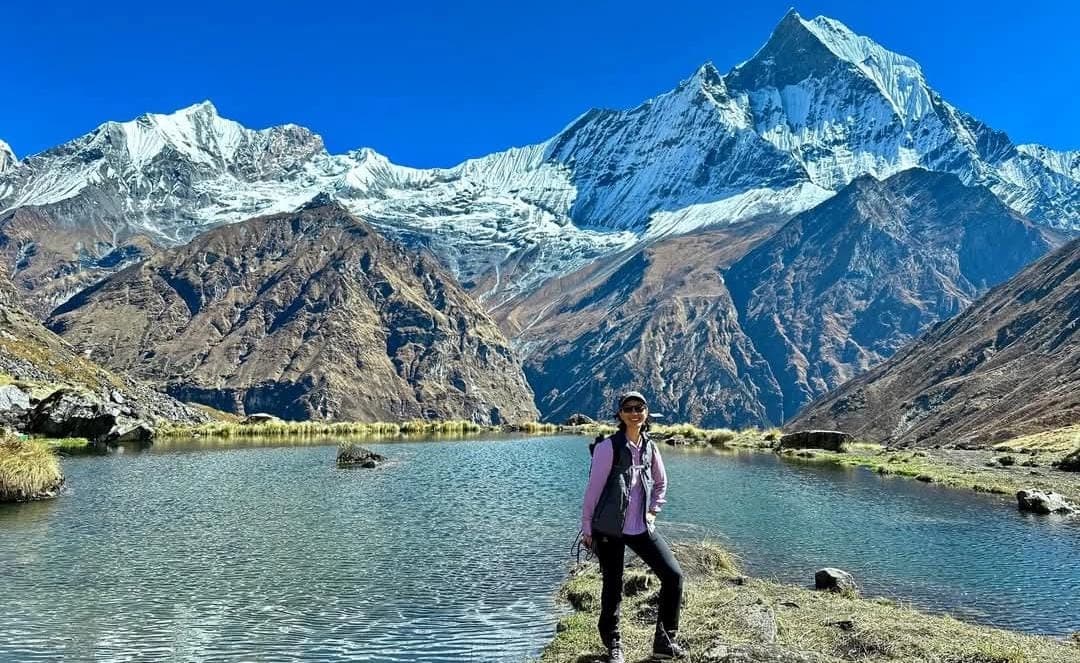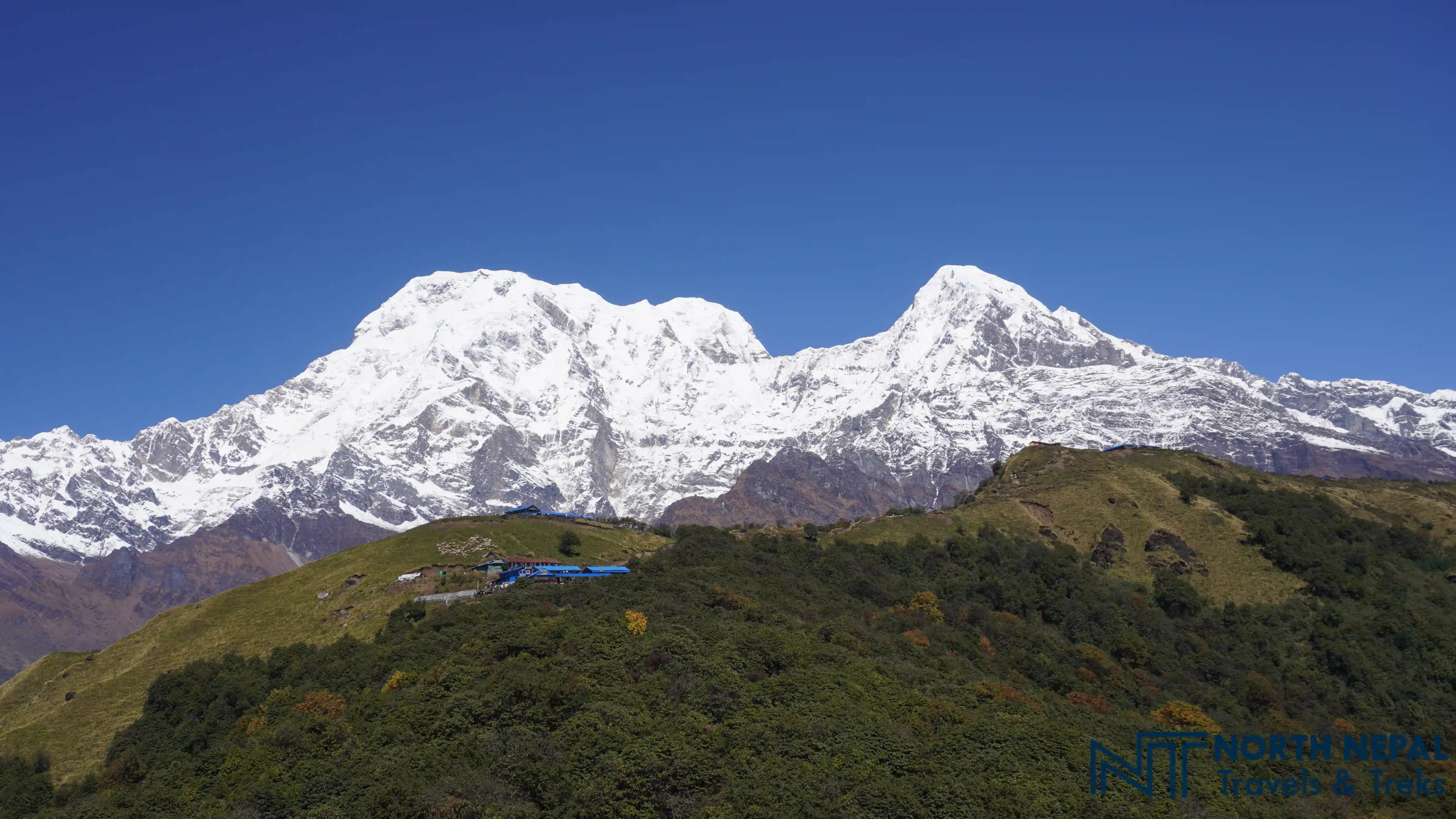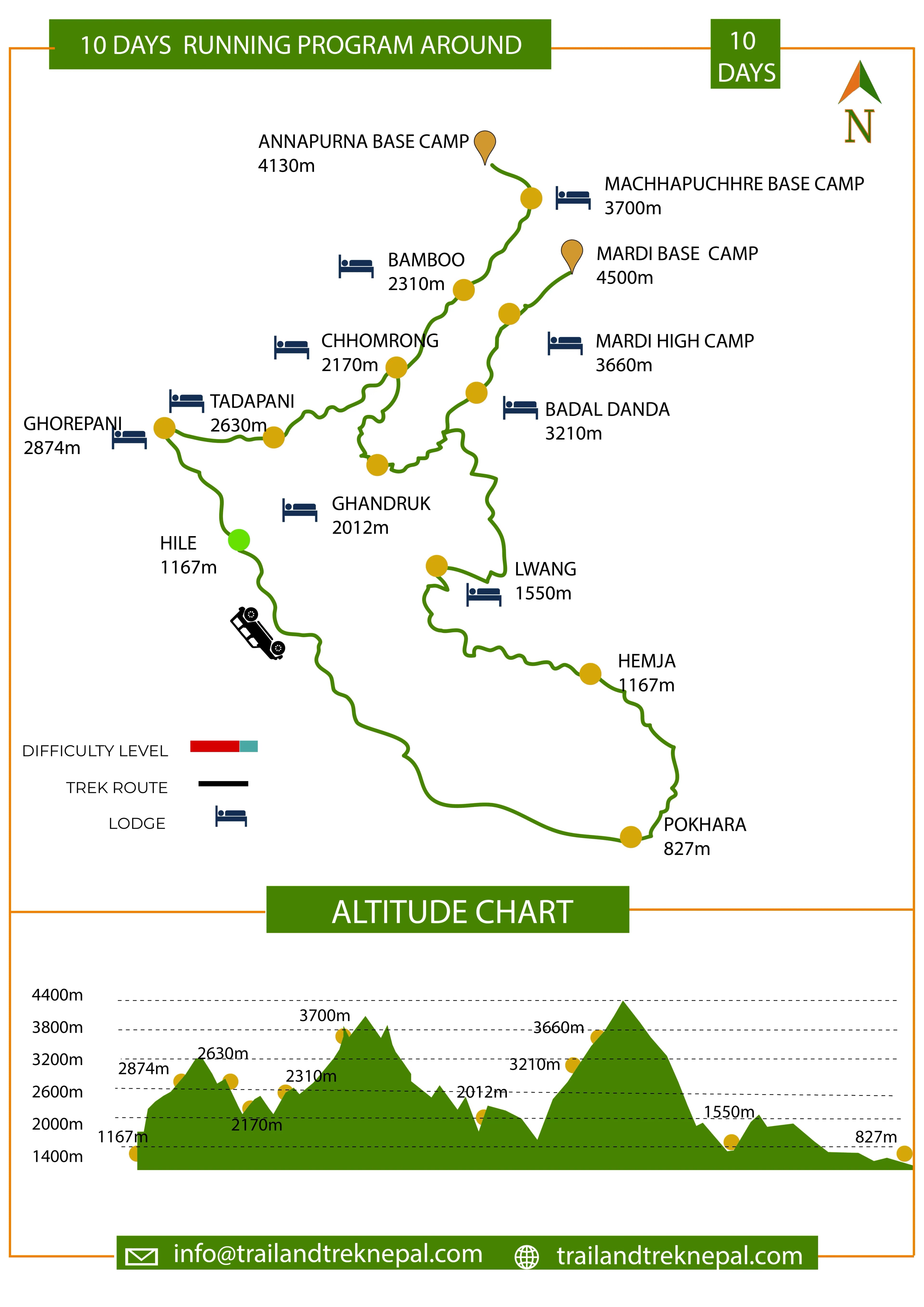

9 Nights 10 Days
We Offer Group Discount
Dec 1 - Dec 1, 2023
Oct 12 - Oct 18, 2025
Oct 12 - Oct 18, 2025
Oct 12 - Dec 18, 2025
Oct 12 - Oct 18, 2025
Annapurna Region
Hotel and Teahouse
Forest and Mountain Trail
Spring and Autumn
Moderate
9 Nights 10 Days
6-7 hours
~ 160 km
The 10 Days Annapurna Sanctuary Trail Running is a moderate Nepal trail race starting from Pokhara and ending at Tatopani. Covering 15–22 km daily with altitudes up to 2,874m (Ghorepani), it passes Gurung villages, rhododendron forests, hot springs at Jhinu Danda, and viewpoints like Panchase, Australian Base Camp, and Mohare Danda. Runners enjoy tea house stays, local hospitality, and panoramic views of Annapurna and Machhapuchhre.
Day | Route | Distance | Duration | Altitude | Elevation Change |
1 | Hile to Ghorepani | 11 km | 2-3 hours | 2,874m | +1,334m gain |
2 | Ghorepani to Tadapani | 14 km | 3 hours | 2,610m | -264m loss |
3 | Tadapani to Bamboo | 17 km | 3-4 hours | 2,310m | -300m loss |
4 | Bamboo to MBC | 10.6 km | 2 hours | 3,700m | +1,390m gain |
5 | MBC to ABC & Back to Chhomrong | 23 km | 5-6 hours | 4,130m/2,170m | +430/-1,530m |
6 | Chhomrong to Ghandruk via Jhinu | 9.6 km | 2 hours | 2,012m | -158m loss |
7 | Ghandruk to Badal Danda | 12.5 km | 2.5 hours | 3,210m | +1,198m gain |
8 | Badal Danda to Mardi BC & High Camp | 14 km | 4 hours | 4,500m/3,550m | +1,290m/-340m |
9 | High Camp to Lwang Village | 20 km | 5 hours | 1,550m | -2,000m loss |
10 | Lwang to Pokhara via Dhampus | 28 km | 5 hours | 822m | -728m loss |
The package includes ACAP and TIMS permits, guides, porters, meals, and lodging. Cost also depends on group size. With diverse terrain—paved roads, forest trails, and steep ascents—it offers both endurance and cultural immersion, making it an ideal introduction to trail running in Nepal.



The 10 Days Annapurna Sanctuary Trail Running Package offers an extraordinary high-altitude running experience through Nepal's most spectacular mountain region. This Himalayan trail challenge takes experienced trail runners from Hile to Pokhara, covering iconic destinations including Annapurna Base Camp (4,130m), Machhapuchhre Base Camp (3,700m), and Mardi Base Camp (4,500m). The program combines extreme trail race conditions with breathtaking mountain views of Annapurna (8,091m), Machhapuchhre (6,993m), and Mardi Himal (5,587m).
This Nepal trail running adventure spans 10 days with a moderate difficulty level suitable for experienced runners. Daily running duration ranges from 6 to 7 hours, covering diverse terrain including paved roads, unpaved trails, and muddy surfaces. The route passes through culturally enriched Gurung villages like Ghandruk and Lwang, offering authentic mountain community experiences. Trail runners encounter rhododendron forests, natural hot springs at Jhinu Danda, and panoramic viewpoints throughout the journey.
The Annapurna Sanctuary trek combines adventure running with altitude training up to 4,500m elevation. Tea house accommodation provides comfortable lodging with traditional mountain hospitality. All necessary permits, including ACAP and TIMS cards, are included. This mountain endurance race challenges participants with steep uphill climbs, technical downhill sections, and long-distance trail running through pristine Himalayan wilderness.
This forest and mountain trail has a moderate difficulty rating. Proper preparation and fitness are essential.
Best season for this adventure is Spring and Autumn. Weather conditions can change rapidly in the mountains.
We'll conduct a pre-trip briefing to discuss the Annapurna Sanctuary Trail Running - 10 Days route, safety guidelines, equipment requirements, and what to expect during your 9 Nights 10 Days adventure.

Any other food/drink should be covered by you, except (3 meals) provided by the company.
Personal equipment
Tips for the Guide and Potter
Additionally, cost due to any unforeseen circumstances, i.e, illness, bad weather, natural calamities, etc.
The main concept of fastpacking is to carry lighter bag will help you travel further distance in lesser time. Fastpacking gears helps trekkers to run and walk cover multiple days. By fitting all necessary supplies into a lightweight backpack, you can travel faster and cover greater distances, enabling you to explore more without needing to return to a fixed base each night.
Spring Season (March-May): Clear mountain views and stable weather patterns are ideal for photography. Rhododendron forest blooms create spectacular natural displays throughout the route. Moderate temperatures are suitable for long-distance running activities. Peak season requires booking for accommodation.
Autumn Season (September-November): Crystal clear mountain visibility and dry trail conditions. Perfect temperature ranges for high-altitude running activities. Stable weather patterns with minimal precipitation. The most popular season requires early reservation.
Monsoon Season (June-August): Heavy rainfall creates muddy and dangerous trail conditions. Cloud cover limits mountain views and photography opportunities. Increased landslide risk along certain trail sections. Not recommended for inexperienced trail runners.
Winter Season (December-February): Cold temperatures and potential snow at high altitudes. Limited tea house operations in remote high-altitude areas. Clear views but challenging conditions requiring additional equipment. Experienced winter mountaineers only recommended.
Daily temperature variations from warm valleys to freezing high altitudes. Weather conditions change rapidly, requiring flexible clothing systems. Rain gear is essential regardless of the season for sudden weather changes. Sun protection is crucial at high altitudes with intense UV exposure.
Annapurna Conservation Area Project (ACAP) Permit: Mandatory for all participants at $25 per person. Covers environmental conservation and trail maintenance fees. Valid throughout the Annapurna Sanctuary trekking region. Supports local conservation and community development programs.
Trekkers Information Management System (TIMS) Card: Essential for safety tracking and emergency coordination. Includes emergency contact information and insurance details. Facilitates rescue operations and safety monitoring. Required for all organized trekking activities in Nepal.
All permit paperwork is handled by the organizing company with advanced processing. Participants provide passport copies and recent photographs for permit applications. Processing requires 1-2 days' advance notice for proper preparation. Emergency permits are available with additional fees and expedited processing.
Required Documents:
Paved Roads: Smooth surfaces enable efficient running speeds through village areas. These sections provide recovery opportunities between technical terrain challenges. Urban approaches and valley floors predominantly feature paved conditions. Trail runners experience optimal traction and pace development on these surfaces.
Unpaved Trails: Mountain paths include dirt, gravel, and rocky surfaces throughout the route. Technical terrain requires careful foot placement and balance maintenance. Forest sections and high-altitude approaches feature predominantly unpaved conditions. These surfaces test technical running skills and equipment durability.
Muddy Sections: Monsoon season and stream crossings create challenging, slippery conditions. Careful navigation prevents accidents and maintains steady progress. Specialized footwear provides essential grip and ankle support. Weather conditions significantly impact muddy trail difficulty levels.
The trek features dramatic elevation changes from 822m to 4,500m in altitude. Significant daily gains include 1,390m (Day 4) and 1,198m (Day 7), testing endurance limits. Major elevation losses reach 2,000m (Day 9), demanding technical downhill skills. Cumulative elevation gain exceeds 6,000m throughout the 10-day program.
High Altitude Effects: Above 3,000m elevation, reduced oxygen levels affect performance significantly. Altitude training benefits include improved cardiovascular efficiency and red blood cell production. Gradual acclimatization prevents serious altitude sickness complications. Please note that individual responses vary considerably.
Weather Patterns: Monsoon season (June-September) increases trail difficulty with mud and cloud cover. The spring season (March-May) provides optimal conditions with rhododendron blooms and clear views. Winter conditions may include snow at higher elevations, requiring additional safety measures.
The Annapurna Sanctuary Nepal region, features a well-developed tea house accommodation system. Traditional mountain lodges provide basic but comfortable facilities throughout the route. Shared bathrooms and common dining areas characterize most accommodations. Local families operate these establishments, providing authentic cultural experiences.
Facility Standards: Basic bedding, blankets, and pillows included in accommodation packages. Hot water availability varies by location and altitude, with additional charges common. Charging facilities for electronic devices are generally available with variable reliability. Wi-fi connectivity is extremely limited in remote high-altitude locations.
Three daily meals included breakfast, lunch, and dinner requirements. Traditional dal bhat provides essential carbohydrates and protein for endurance activities. Tea and coffee are served twice daily, maintaining hydration and warmth. Fresh and dry fruits supplement nutrition throughout the challenging trail conditions.
Menu Varieties:
Water bottle storage for hot water helps maintain warmth during cold, high-altitude nights. Water purification tablets or systems are essential for safe drinking water throughout the trek. Basic toilet facilities improve with decreasing altitude and proximity to main trails. Hygiene standards vary significantly between locations, requiring personal preparation.
This mountain endurance race demands excellent cardiovascular fitness and leg strength. Previous trail running experience is essential for technical terrain navigation. High-altitude exposure benefits preparation, but not mandatory for participation. An overall health assessment is recommended before committing to this challenging program.
Training Duration: Several weeks to months of preparation recommended for optimal performance. A consistent training schedule prevents injury and ensures program completion. 2-3 weekly training sessions minimum requirement for adequate preparation. Personalized training advice available based on individual fitness levels.
Strength Training Focus:
Toes-to-bar for grip strength and functional movement patterns
Cardiovascular Preparation:
High-altitude exposure improves oxygen utilization efficiency and red blood cell production. Cardiovascular adaptations enhance performance at sea level upon return. Mental preparation for thin air conditions reduces anxiety and improves performance. Gradual exposure prevents serious altitude-related health complications.
Technical Clothing: Moisture-wicking shorts and t-shirts prevent chafing and discomfort during long days. Quick-dry materials are essential for changing weather conditions and daily washing needs. Multiple sets are required for a 10-day program with limited washing opportunities. The layering system accommodates temperature variations from the valley to the high altitude.
Footwear Requirements: Trail running boots with excellent grip are mandatory for mixed terrain conditions. Ankle support prevents injury on uneven rocky surfaces and steep descents. Waterproof or water-resistant features protect against stream crossings and wet conditions. Comfortable fit is essential for long daily distances and extended program duration.
Pack System: Lightweight backpack for daily essentials, including a water bottle, medications, and emergency supplies. Comfortable shoulder straps and back support prevent fatigue during long running days. Easy access pockets for frequently needed items like energy bars and first aid supplies.
Professional guides carry comprehensive safety and emergency equipment. First aid medical kit includes an oximeter for altitude monitoring. Emergency communication devices ensure rescue coordination if needed. Group cooking and camping equipment are required for remote sections.
The maximum altitude of 4,500m requires careful monitoring and gradual ascent protocols. Altitude training helps but cannot completely prevent altitude-related symptoms. Immediate descent is necessary if serious symptoms develop during the program. Comprehensive first aid training for guides ensures appropriate emergency response.
Common Symptoms:
Experienced guides carry a comprehensive first aid medical kit with an oximeter for monitoring. Emergency evacuation procedures have been established with helicopter rescue coordination. Communication equipment enables contact with rescue services and medical facilities. Travel insurance covering high-altitude activities is strongly recommended for all participants.
Medical Support:
Mountain weather conditions change rapidly, requiring constant monitoring and preparation. Monsoon season increases landslide and flooding risks along certain trail sections. Winter conditions may include snow and ice at higher elevations, demanding additional safety equipment. Weather-related program modifications are possible for participant safety.
Professional trail running guides with extensive mountain experience and safety training. Local area expertise includes weather patterns, trail conditions, and cultural knowledge. First aid certification and emergency response training for high-altitude situations. English language communication skills and international experience with diverse groups.
Guide Responsibilities:
One porter for every two participants ensures adequate gear carrying capacity. Maximum 15-20 kg carrying limits per porter, following ethical employment standards. Group equipment transport, including safety gear and emergency supplies. Personal gear carrying is optional with additional cost arrangements.
Porter Welfare Standards:
The trek operates within a protected conservation area with strict environmental regulations. Leave no trace principles are mandatory for all participants and support staff. Wildlife protection includes rare species like the snow leopard and the blue sheep. Habitat conservation efforts protect fragile alpine ecosystems.
Conservation Guidelines:
Local community involvement ensures tourism benefits reach mountain villages. Traditional lifestyle preservation is supported through cultural tourism initiatives. Environmental education promotes awareness among international visitors. Conservation funding is generated through permit fees and tourism taxes.
Sustainability Elements:
This program provides excellent training for extreme trail race competitions worldwide. High-altitude running experience develops cardiovascular efficiency and mental toughness. Technical terrain navigation skills transfer to other mountain running challenges. Cultural immersion adds unique elements to standard racing preparation.
Daily distances ranging from 9-28 kilometers provide progressive endurance building. Varied terrain conditions prepare runners for diverse racing environments. Elevation changes develop specific muscle groups and running techniques. Mental preparation for multi-day efforts builds psychological resilience.
Mixed surface conditions develop technical running abilities for competition. Steep uphill and downhill sections build specialized muscle strength. Navigation skills improve through varied terrain and weather conditions. Equipment testing opportunities for gear optimization and selection.
This comprehensive Annapurna Sanctuary trail run program combines adventure running with cultural immersion in Nepal's most spectacular mountain region. The challenging 10-day journey provides unforgettable experiences while testing physical and mental limits through diverse terrain and altitude challenges.
Annapurna Sanctuary Trail Running - 10 Days is available for booking on the dates below. Please inquire for the best deal or share with friends to plan together. All trips are group based. For custom trips, contact us.